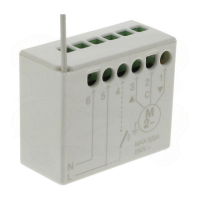5
Led flashes Code type of memorised transmitters
1 short flash (total 0.2s) Transmitters with FLO code
2 short flashes (total 0.4s) Transmitters with FLOR code
3 short flashes (total 0,6s) Transmitters with SMILO code
2 long flashes (total 1.5s) Memory empty (no transmitter memorised)
FLO4R VERY SM4 SM2
4.1) Compatible transmitters
Table A5 specifies the transmitters and relative type of code that can
be used with the TT2N control unit.
As transmitter codes are different and the control unit cannot recognise them simultaneously, the first memorised transmitter determines the
type of code and therefore the type of transmitters that can be subsequently memorised. After memorisation of the first transmitter, if the
type of transmitter needs to be changed, all transmitters will have to be deleted from the memory (table A4).
The type of code can be checked by the number of flashes emitted by the led on start-up.
Coding Transmitters
ERGO1 - ERGO4 - ERGO6
PLANO1 - PLANO4 - PLANO6 - PLANO TIME
FLOR Rolling code VOLO S RADIO
FLO1R - FLO2R - FLO4R
VERY VR
SMILO Rolling code SM2 - SM4
FLO Fixed code
FLO1 - FLO2 - FLO4
VERY VE
Table “A5”
4.2) Memorising transmitters in Mode I and Mode II
Tables A1, A2 and A3 describe the memorisation of transmitters in Mode I where the transmitter is memorised in blocks and each key cor-
responds to a specific command (table A6). Mode I is used to control an automation with the 3 or 4 keys of the transmitters.
Transmitters can also be memorised on the TT2N control unit using Mode II, which enables more flexibility in terms of transmitter key use.
Transmitters can be memorised using both Mode I and Mode II on the same control unit.
4.2.1) Mode I
In Mode I the command associated with the transmitter keys is fixed
(table A6). In Mode I only one memorisation phase is performed for
each transmitter and only one memory location is occupied. During
memorisation in Mode I it is not important which key is pressed
on the transmitter.
ERGO PLANO NICEWAY VOLO S RADIO
4) Further details
The TT2N control unit, in addition to the transmitters in the series ERGO, PLANO and NICEWAY, can recognise other types of transmitters
produced by Nice (paragraph 4.1 Compatible transmitters). Specific transmitter memorisation procedures also enable the association of each
transmitter key with a specific command (paragraphes 4.2.1 Mode I and 4.2.2 Mode II).
Key Command
Key s or 1 Up
Key n or 2 Stop
Key t or 3 Down
Key 4 “Hold-to-run” Down
Table “A6”: memorisation using Mode I
4.2.2) Mode II
In Mode II each key of the transmitter can be associated with one
of 6 possible commands (table A7); for example one automation
can be controlled with just one key memorised for the Step-by-step
command, while the other keys are left free for control of other auto-
mations. In Mode II one memorisation phase is performed for each
key and each occupies one location in the memory. During memori-
sation used in Mode II the specific key pressed is memorised. If
another key is to be assigned a command on the same transmitter,
a new memorisation phase must be performed for that specific key.
N° Command
1 Step-by-step (Up- Stop- Down Stop )
2 Up-Stop
3 Down-Stop
4 Stop
5 “Hold-to-run” Down
6 “Hold-to-run” Up
Table “A7”: memorisation using Mode II
EN

